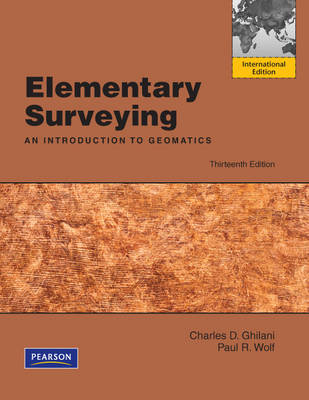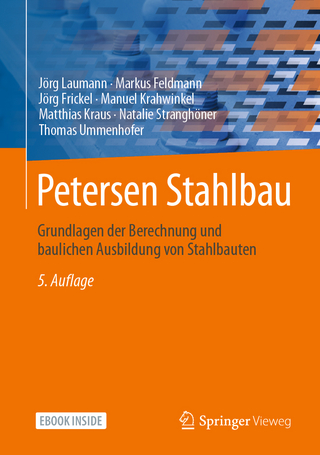
Elementary Surveying
Pearson Education Limited (Verlag)
978-0-273-75144-1 (ISBN)
- Titel erscheint in neuer Auflage
- Artikel merken
This highly readable, best-selling text presents basic concepts and practical material in each of the areas fundamental to modern surveying (geomatics) practice. Its depth and breadth are ideal for self-study. The 13th Edition is updated throughout to reflect the latest advances and technology.
1 INTRODUCTION 1
1.1 Definition of Surveying 1
1.2 Geomatics 3
1.3 History of Surveying 4
1.4 Geodetic and Plane Surveys 9
1.5 Importance of Surveying 10
1.6 Specialized Types of Surveys 11
1.7 Surveying Safety 13
1.8 Land and Geographic Information Systems 14
1.9 Federal Surveying and Mapping Agencies 15
1.10 The Surveying Profession 16
1.11 Professional Surveying Organizations 17
1.12 Surveying on the Internet 18
1.13 Future Challenges in Surveying 19
Problems 20
Bibliography 21
2 UNITS, SIGNIFICANT FIGURES, AND FIELD NOTES 23
PART I UNITS AND SIGNIFICANT FIGURES 23
2.1 Introduction 23
2.2 Units of Measurement 23
2.3 International System of Units (SI) 25
2.4 Significant Figures 27
2.5 Rounding Off Numbers 29
PART II FIELD NOTES 30
2.6 Field Notes 30
2.7 General Requirements of Handwritten Field Notes 31
2.8 Types of Field Books 32
2.9 Kinds of Notes 33
2.10 Arrangements of Notes 33
2.11 Suggestions for Recording Notes 35
2.12 Introduction to Data Collectors 36
2.13 Transfer of Files from Data Collectors 39
2.14 Digital Data File Management 41
2.15 Advantages and Disadvantages of Data Collectors 42
Problems 43
Bibliography 44
3 THEORY OF ERRORS IN OBSERVATIONS 45
3.1 Introduction 45
3.2 Direct and Indirect Observations 45
3.3 Errors in Measurements 46
3.4 Mistakes 46
3.5 Sources of Errors in Making Observations 47
3.6 Types of Errors 47
3.7 Precision and Accuracy 48
3.8 Eliminating Mistakes and Systematic Errors 49
3.9 Probability 49
3.10 Most Probable Value 50
3.11 Residuals 51
3.12 Occurrence of Random Errors 51
3.13 General Laws of Probability 55
3.14 Measures of Precision 55
3.15 Interpretation of Standard Deviation 58
3.16 The 50, 90, and 95 Percent Errors 58
3.17 Error Propagation 60
3.18 Applications 65
3.19 Conditional Adjustment of Observations 65
3.20 Weights of Observations 66
3.21 Least-Squares Adjustment 67
3.22 Using Software 68
Problems 69
Bibliography 71
4 LEVELING THEORY, METHODS, AND EQUIPMENT 73
PART I LEVELING THEORY AND METHODS 73
4.1 Introduction 73
4.2 Definitions 73
4.3 North American Vertical Datum 75
4.4 Curvature and Refraction 76
4.5 Methods for Determining Differences in Elevation 78
PART II EQUIPMENT FOR DIFFERENTIAL LEVELING 85
4.6 Categories of Levels 85
4.7 Telescopes 86
4.8 Level Vials 87
4.9 Tilting Levels 89
4.10 Automatic Levels 90
4.11 Digital Levels 91
4.12 Tripods 93
4.13 Hand Level 93
4.14 Level Rods 94
4.15 Testing and Adjusting Levels 96
Problems 100
Bibliography 102
5 LEVELING FIELD PROCEDURES AND COMPUTATIONS 103
5.1 Introduction 103
5.2 Carrying and Setting Up a Level 103
5.3 Duties of a Rodperson 105
5.4 Differential Leveling 106
5.5 Precision 112
5.6 Adjustments of Simple Level Circuits 113
5.7 Reciprocal Leveling 114
5.8 Three-Wire Leveling 115
5.9 Profile Leveling 117
5.10 Grid, Cross-Section, or Borrow-Pit Leveling 121
5.11 Use of the Hand Level 122
5.12 Sources of Error in Leveling 122
5.13 Mistakes 124
5.14 Reducing Errors and Eliminating Mistakes 125
5.15 Using Software 125
Problems 127
Bibliography 129
6 DISTANCE MEASUREMENT 131
PART I METHODS FOR MEASURING DISTANCES 131
6.1 Introduction 131
6.2 Summary of Methods for Making Linear Measurements 131
6.3 Pacing 132
6.4 Odometer Readings 132
6.5 Optical Rangefinders 133
6.6 Tacheometry 133
6.7 Subtense Bar 133
PART II DISTANCE MEASUREMENTS BY TAPING 133
6.8 Introduction to Taping 133
6.9 Taping Equipment and Accessories 134
6.10 Care of Taping Equipment 135
6.11 Taping on Level Ground 136
6.12 Horizontal Measurements on Sloping Ground 138
6.13 Slope Measurements 140
6.14 Sources of Error in Taping 141
6.15 Tape Problems 145
6.16 Combined Corrections in a Taping Problem 147
PART III ELECTRONIC DISTANCE MEASUREMENT 148
6.17 Introduction 148
6.18 Propagation of Electromagnetic Energy 149
6.19 Principles of Electronic Distance Measurement 152
6.20 Electro-Optical Instruments 153
6.21 Total Station Instruments 156
6.22 EDM Instruments Without Reflectors 157
6.23 Computing Horizontal Lengths from Slope Distances 158
6.24 Errors in Electronic Distance Measurement 160
6.25 Using Software 165
Problems 165
Bibliography 168
7 ANGLES, AZIMUTHS, AND BEARINGS 169
7.1 Introduction 169
7.2 Units of Angle Measurement 169
7.3 Kinds of Horizontal Angles 170
7.4 Direction of a Line 171
7.5 Azimuths 172
7.6 Bearings 173
7.7 Comparison of Azimuths and Bearings 174
7.8 Computing Azimuths 175
7.9 Computing Bearings 177
7.10 The Compass and the Earth's Magnetic Field 179
7.11 Magnetic Declination 180
7.12 Variations in Magnetic Declination 181
7.13 Software for Determining Magnetic Declination 183
7.14 Local Attraction 184
7.15 Typical Magnetic Declination Problems 185
7.16 Mistakes 187
Problems 187
Bibliography 189
8 TOTAL STATION INSTRUMENTS; ANGLE OBSERVATIONS 191
PART I TOTAL STATION INSTRUMENTS 191
8.1 Introduction 191
8.2 Characteristics of Total Station Instruments 191
8.3 Functions Performed by Total Station Instruments 194
8.4 Parts of a Total Station Instrument 195
8.5 Handling and Setting Up a Total Station Instrument 199
8.6 Servo-Driven and Remotely Operated Total Station Instruments 201
PART II ANGLE OBSERVATIONS 203
8.7 Relationship of Angles and Distances 203
8.8 Observing Horizontal Angles with Total Station Instruments 204
8.9 Observing Horizontal Angles by the Direction Method 206
8.10 Closing the Horizon 207
8.11 Observing Deflection Angles 209
8.12 Observing Azimuths 211
8.13 Observing Vertical Angles 211
8.14 Sights and Marks 213
8.15 Prolonging a Straight Line 214
8.16 Balancing-In 216
8.17 Random Traverse 217
8.18 Total Stations for Determining Elevation Differences 218
8.19 Adjustment of Total Station Instruments and Their Accessories 219
8.20 Sources of Error in Total Station Work 222
8.21 Propagation of Random Errors in Angle Observations 228
8.22 Mistakes 228
Problems 229
Bibliography 230
9 TRAVERSING 231
9.1 Introduction 231
9.2 Observation of Traverse Angles or Directions 233
9.3 Observation of Traverse Lengths 234
9.4 Selection of Traverse Stations 235
9.5 Referencing Traverse Stations 235
9.6 Traverse Field Notes 237
9.7 Angle Misclosure 238
9.8 Traversing with Total Station Instruments 239
9.9 Radial Traversing 240
9.10 Sources of Error in Traversing 241
9.11 Mistakes in Traversing 242
Problems 242
10 TRAVERSE COMPUTATIONS 245
10.1 Introduction 245
10.2 Balancing Angles 246
10.3 Computation of Preliminary Azimuths or Bearings 248
10.4 Departures and Latitudes 249
10.5 Departure and Latitude Closure Conditions 251
10.6 Traverse Linear Misclosure and Relative Precision 251
10.7 Traverse Adjustment 252
10.8 Rectangular Coordinates 255
10.9 Alternative Methods for Making Traverse Computations 256
10.10 Inversing 260
10.11 Computing Final Adjusted Traverse Lengths and Directions 261
10.12 Coordinate Computations in Boundary Surveys 263
10.13 Use of Open Traverses 265
10.14 State Plane Coordinate Systems 268
10.15 Traverse Computations Using Computers 269
10.16 Locating Blunders in Traverse Observations 269
10.17 Mistakes in Traverse Computations 272
Problems 272
Bibliography 275
11 COORDINATE GEOMETRY IN SURVEYING CALCULATIONS 277es and Circles 278
11.3 Perpendicular Distance from a Point to a Line 280
11.4 Intersection of Two Lines, Both Having Known Directions 282
11.5 Intersection of a Line with a Circle 284
11.6 Intersection of Two Circles 287
11.7 Three-Point Resection 289
11.8 Two-Dimensional Conformal Coordinate Transformation 292
11.9 Inaccessible Point Problem 297
11.10 Three-Dimensional Two-Point Resection 299
11.11 Software 302
Problems 303
Bibliography 307
12 AREA 309
12.1 Introduction 309
12.2 Methods of Measuring Area 309
12.3 Area by Division Into Simple Figures 310
12.4 Area by Offsets from Straight Lines 311
12.5 Area by Coordinates 313
12.6 Area by Double-Meridian Distance Method 317
12.7 Area of Parcels with Circular Boundaries 320
12.8 Partitioning of Lands 321
12.9 Area by Measurements from Maps 325
12.10 Software 327
12.11 Sources of Error in Determining Areas 328
12.12 Mistakes in Determining Areas 328
Problems 328
Bibliography 330
13 GLOBAL NAVIGATION SATELLITE SYSTEMS INTRODUCTION AND PRINCIPLES OF OPERATION 331
13.1 Introduction 331
13.2 Overview of GPS 332
13.3 The GPS Signal 335
13.4 Reference Coordinate Systems 337
13.5 Fundamentals of Satellite Positioning 345
13.6 Errors in Observations 348
13.7 Differential Positioning 356
13.8 Kinematic Methods 358
13.9 Relative Positioning 359
13.10 Other Satellite Navigation Systems 362
13.11 The Future 364
Problems 365
Bibliography 366
14 GLOBAL NAVIGATION SATELLITE SYSTEMS STATIC SURVEYS 367
14.1 Introduction 367
14.2 Field Procedures in Satellite Surveys 369
14.3 Planning Satellite Surveys 372
14.4 Performing Static Surveys 384
14.5 Data Processing and Analysis 386
14.6 Sources of Errors in Satellite Surveys 393
14.7 Mistakes in Satellite Surveys 395
Problems 395
Bibliography 397
15 GLOBAL NAVIGATION SATELLITE SYSTEMS KINEMATIC SURVEYS 399
15.1 Introduction 399
15.2 Planning of Kinematic Surveys 400
15.3 Initialization 402
15.4 Equipment Used in Kinematic Surveys 403
15.5 Methods Used in Kinematic Surveys 405
15.6 Performing Post-Processed Kinematic Surveys 408
15.7 Communication in Real-Time Kinematic Surveys 411
15.8 Real-Time Networks 412
15.9 Performing Real-Time Kinematic Surveys 413
15.10 Machine Control 414
15.11 Errors in Kinematic Surveys 418
15.12 Mistakes in Kinematic Surveys 418
Problems 418
Bibliography 419
16 ADJUSTMENTS BY LEAST SQUARES 421
16.1 Introduction 421
16.2 Fundamental Condition of Least Squares 423
16.3 Least-Squares Adjustment by the Observation Equation Method 424
16.4 Matrix Methods in Least-Squares Adjustment 428
16.5 Matrix Equations for Precisions of Adjusted Quantities 430
16.6 Least-Squares Adjustment of Leveling Circuits 432
16.7 Propagation of Errors 436
16.8 Least-Squares Adjustment of GNSS Baseline Vectors 437
16.9 Least-Squares Adjustment of Conventional Horizontal Plane Surveys 443
16.10 The Error Ellipse 452
16.11 Adjustment Procedures 457
16.12 Other Measures of Precision for Horizontal Stations 458
16.13 Software 460
16.14 Conclusions 460
Problems 461
Bibliography 466
17 MAPPING SURVEYS 467
17.1 Introduction 467
17.2 Basic Methods for Performing Mapping Surveys 468
17.3 Map Scale 468
17.4 Control for Mapping Surveys 470
17.5 Contours 471
17.6 Characteristics of Contours 474
17.7 Direct and Indirect Methods of Locating Contours 474
17.8 Digital Elevation Models and Automated Contouring Systems 477
17.9 Basic Field Methods for Locating Topographic Details 479
17.10 Three-Dimensional Conformal Coordinate Transformation 488
17.11 Selection of Field Method 489
17.12 Working with Data Collectors and Field-to-Finish Software 490
17.13 Hydrographic Surveys 493
17.14 Sources of Error in Mapping Surveys 497
17.15 Mistakes in Mapping Surveys 498
Problems 498
Bibliography 500
18 MAPPING 503
18.1 Introduction 503
18.2 Availability of Maps and Related Information 504
18.3 National Mapping Program 505
18.4 Accuracy Standards for Mapping 505
18.5 Manual and Computer-Aided Drafting Procedures 507
18.6 Map Design 508
18.7 Map Layout 510
18.8 Basic Map Plotting Procedures 512
18.9 Contour Interval 514
18.10 Plotting Contours 514
18.11 Lettering 515
18.12 Cartographic Map Elements 516
18.13 Drafting Materials 519
18.14 Automated Mapping and Computer-Aided Drafting Systems 519
18.15 Impacts of Modern Land and Geographic Information Systems on Mapping 525
18.16 Sources of Error in Mapping 526
18.17 Mistakes in Mapping 526
Problems 526
Bibliography 528
19 CONTROL SURVEYS AND GEODETIC REDUCTIONS 529
19.1 Introduction 529
19.2 The Ellipsoid and Geoid 530
19.3 The Conventional Terrestrial Pole 532
19.4 Geodetic Position and Ellipsoidal Radii of Curvature 534
19.5 Geoid Undulation and Deflection of the Vertical 536
19.6 U.S. Reference Frames 538
19.7 Accuracy Standards and Specifications for Control Surveys 547
19.8 The National Spatial Reference System 550
19.9 Hierarchy of the National Horizontal Control Network 550
19.10 Hierarchy of the National Vertical Control Network 551
19.11 Control Point Descriptions 551
19.12 Field Procedures for Traditional Horizontal Control Surveys 554
19.13 Field Procedures for Vertical Control Surveys 559
19.14 Reduction of Field Observations to Their Geodetic Values 564
19.15 Geodetic Position Computations 577
19.16 The Local Geodetic Coordinate System 580
19.17 Three-Dimensional Coordinate Computations 581
19.18 Software 584
Problems 584
Bibliography 587
20 STATE PLANE COORDINATES AND OTHER MAP PROJECTIONS 589
20.1 Introduction 589
20.2 Projections Used in State Plane Coordinate Systems 590
20.3 Lambert Conformal Conic Projection 593
20.4 Transverse Mercator Projection 594
20.5 State Plane Coordinates in NAD27 and NAD83 595
20.6 Computing SPCS83 Coordinates in the Lambert Conformal Conic System 596
20.7 Computing SPCS83 Coordinates in the Transverse Mercator System 601
20.8 Reduction of Distances and Angles to State Plane Coordinate Grids 608
20.9 Computing State Plane Coordinates of Traverse Stations 617
20.10 Surveys Extending from One Zone to Another 620
20.11 Conversions Between SPCS27 and SPCS83 621
20.12 The Universal Transverse Mercator Projection 622
20.13 Other Map Projections 623
20.14 Map Projection Software 627
Problems 628
Bibliography 631
21 BOUNDARY SURVEYS 633
21.1 Introduction 633
21.2 Categories of Land Surveys 634
21.3 Historical Perspectives 635
21.4 Property Description by Metes and Bounds 636
21.5 Property Description by Block-and-Lot System 639
21.6 Property Description by Coordinates 641
21.7 Retracement Surveys 641
21.8 Subdivision Surveys 644
21.9 Partitioning Land 646
21.10 Registration of Title 647
21.11 Adverse Possession and Easements 648
21.12 Condominium Surveys 648
21.13 Geographic and Land Information Systems 655
21.14 Sources of Error in Boundary Surveys 655
21.15 Mistakes 655
Problems 656
Bibliography 658
22 SURVEYS OF THE PUBLIC LANDS 659
22.1 Introduction 659
22.2 Instructions for Surveys of the Public Lands 660
22.3 Initial Point 663
22.4 Principal Meridian 664
22.5 Baseline 665
22.6 Standard Parallels (Correction Lines) 666
22.7 Guide Meridians 666
22.8 Township Exteriors, Meridional (Range) Lines, and Latitudinal (Township) Lines 667
22.9 Designation of Townships 668
22.10 Subdivision of a Quadrangle into Townships 668
22.11 Suions 671
22.13 Fractional Sections 672
22.14 Notes 672
22.15 Outline of Subdivision Steps 672
22.16 Marking Corners 674
22.17 Witness Corners 674
22.18 Meander Corners 675
22.19 Lost and Obliterated Corners 675
22.20 Accuracy of Public Lands Surveys 678
22.21 Descriptions by Township Section and Smaller Subdivision 678
22.22 BLM Land Information System 679
22.23 Sources of Error 680
22.24 Mistakes 680
Problems 681
Bibliography 683
23 CONSTRUCTION SURVEYS 685
23.1 Introduction 685
23.2 Specialized Equipment for Construction Surveys 686
23.3 Horizontal and Vertical Control 689
23.4 Staking Out a Pipeline 691
23.5 Staking Pipeline Grades 692
23.6 Staking Out a Building 694
23.7 Staking Out Highways 698
23.8 Other Construction Surveys 703
23.9 Construction Surveys Using Total Station Instruments 704
23.10 Construction Surveys Using GNSS Equipment 706
23.11 Machine Guidance and Control 709
23.12 As-Built Surveys with Laser Scanning 710
23.13 Sources of Error in Construction Surveys 711
23.14 Mistakes 712
Problems 712
Bibliography 714
24 HORIZONTAL CURVES 715
24.1 Introduction 715
24.2 Degree of Circular Curve 716
24.3 Definitions and Derivation of Circular Curve Formulas 718
24.4 Circular Curve Stationing 720
24.5 General Procedure of Circular Curve Layout by Deflection Angles 721
24.6 Computing Deflection Angles and Chords 723
24.7 Notes for Circular Curve Layout by Deflection Angles and Incremental Chords 725
24.8 Detailed Procedures for Circular Curve Layout by Deflection Angles and Incremental Chords 726
24.9 Setups on Curve 727
24.10 Metric Circular Curves by Deflection Angles and Incremental Chords 728
24.11 Circular Curve Layout by Deflection Angles and Total Chords 730
24.12 Computation of Coordinates on a Circular Curve 731
24.13 Circular Curve Layout by Coordinates 733
24.14 Curve Stakeout Using GNSS Receivers and Robotic Total Stations 738
24.15 Circular Curve Layout by Offsets 739
24.16 Special Circular Curve Problems 742
24.17 Compound and Reverse Curves 743
24.18 Sight Distance on Horizontal Curves 743
24.19 Spirals 744
24.20 Computation of "As-Built" Circular Alignments 749
24.21 Sources of Error in Laying Out Circular Curves 752
24.22 Mistakes 752
Problems 753
Bibliography 755
25 VERTICAL CURVES 757
25.1 Introduction 757
25.2 General Equation of a Vertical Parabolic Curve 758
25.3 Equation of an Equal Tangent Vertical Parabolic Curve 759
25.4 High or Low Point on a Vertical Curve 761
25.5 Vertical Curve Computations Using the Tangent Offset Equation 761
25.6 Equal Tangent Property of a Parabola 765
25.7 Curve Computations by Proportion 766
25.8 Staking a Vertical Parabolic Curve 766
25.9 Machine Control in Grading Operations 767
25.10 Computations for an Unequal Tangent Vertical Curve 767
25.11 Designing a Curve to Pass Through a Fixed Point 770
25.12 Sight Distance 771
25.13 Sources of Error in Laying Out Vertical Curves 773
25.14 Mistakes 774
Problems 774
Bibliography 776
26 VOLUMES 777
26.1 Introduction 777
26.2 Methods of Volume Measurement 777
26.3 The Cross-Section Method 778
26.4 Types of Cross Sections 779
26.5 Average-End-Area Formula 780
26.6 Determining End Areas 781
26.7 Computing Slope Intercepts 784
26.8 Prismoidal Formula 786
26.9 Volume Computations 788
26.10 Unit-Area, or Borrow-Pit, Method 790
26.11 Contour-Area Method 791
26.12 Measuring Volumes of Water Discharge 793
26.13 Software 794
26.14 Sources of Error in Determining Volumes 795
26.15 Mistakes 795
Problems 795
Bibliography 798
27 PHOTOGRAMMETRY 799
27.1 Introduction 799
27.2 Uses of Photogrammetry 800
27.3 Aerial Cameras 801
27.4 Types of Aerial Photographs 803
27.5 Vertical Aerial Photographs 804
27.6 Scale of a Vertical Photograph 806
27.7 Ground Coordinates from a Single Vertical Photograph 810
27.8 Relief Displacement on a Vertical Photograph 811
27.9 Flying Height of a Vertical Photograph 813
27.10 Stereoscopic Parallax 814
27.11 Stereoscopic Viewing 817
27.12 Stereoscopic Measurement of Parallax 819
27.13 Analytical Photogrammetry 820
27.14 Stereoscopic Plotting Instruments 821
27.15 Orthophotos 826
27.16 Ground Control for Photogrammetry 827
27.17 Flight Planning 828
27.18 Airborne Laser-Mapping Systems 830
27.19 Remote Sensing 831
27.20 Software 837
27.21 Sources of Error in Photogrammetry 838
27.22 Mistakes 838
Problems 839
Bibliography 842
28 INTRODUCTION TO GEOGRAPHIC INFORMATION SYSTEMS 843
28.1 Introduction 843
28.2 Land Information Systems 846
28.3 GIS Data Sources and Classifications 846
28.4 Spatial Data 846
28.5 Nonspatial Data 852
28.6 Data Format Conversions 853
28.7 Creating GIS Databases 856
28.8 Metadata 862
28.9 GIS Analytical Functions 862
28.10 GIS Applications 867
28.11 Data Sources 867
Problems 869
Bibliography 871
APPENDIX A DUMPY LEVELS, TRANSITS, AND THEODOLITES 873
APPENDIX B EXAMPLE NOTEFORMS 888
APPENDIX C ASTRONOMICAL OBSERVATIONS 895
APPENDIX D USING THE WORKSHEETS FROM THE COMPANION WEBSITE 911
APPENDIX E INTRODUCTION TO MATRICES 917
APPENDIX F U.S. STATE PLANE COORDINATE SYSTEM DEFINING PARAMETERS 923
APPENDIX G ANSWERS TO SELECTED PROBLEMS 927
INDEX 933
| Erscheint lt. Verlag | 30.3.2011 |
|---|---|
| Verlagsort | Harlow |
| Sprache | englisch |
| Maße | 189 x 230 mm |
| Gewicht | 1280 g |
| Themenwelt | Schulbuch / Wörterbuch |
| Technik ► Bauwesen | |
| ISBN-10 | 0-273-75144-1 / 0273751441 |
| ISBN-13 | 978-0-273-75144-1 / 9780273751441 |
| Zustand | Neuware |
| Informationen gemäß Produktsicherheitsverordnung (GPSR) | |
| Haben Sie eine Frage zum Produkt? |
aus dem Bereich



